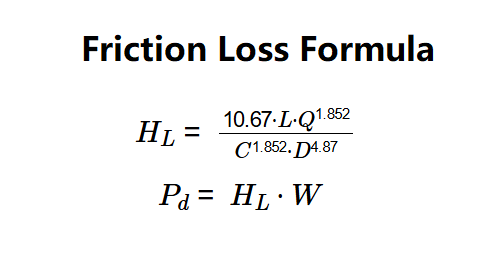1. What is Friction Loss Calculator?
Definition: This calculator computes the friction head loss (\( H_L \)) and pressure drop (\( P_d \)) in a pipe using the Hazen-Williams equation, based on the pipe length, diameter, volumetric flow rate, and Hazen-Williams coefficient.
Purpose: It is used in fluid dynamics and engineering to estimate pressure losses due to friction in pipes, aiding in the design and analysis of water distribution systems, irrigation, and other piping networks.
2. How Does the Calculator Work?
The calculator uses the Hazen-Williams equation in SI units:
- \( H_L = \frac{10.67 \cdot L \cdot Q^{1.852}}{C^{1.852} \cdot D^{4.87}} \)
The pressure drop is calculated as:
Where:
- \( H_L \): Friction head loss (m, converted to selected unit);
- \( L \): Pipe length (m);
- \( Q \): Volumetric flow rate (m³/s);
- \( D \): Pipe diameter (m);
- \( C \): Hazen-Williams coefficient (dimensionless);
- \( P_d \): Pressure drop (Pa, converted to selected unit);
- \( W \): Specific weight of water (9810 N/m³).
Steps:
- Enter the Hazen-Williams coefficient (\( C \)) by selecting a material or entering a custom value.
- Enter the pipe length (\( L \)) with its unit.
- Enter the pipe diameter (\( D \)) with its unit.
- Enter the volumetric flow rate (\( Q \)) with its unit.
- Convert \( L \), \( D \), and \( Q \) to SI units (m, m, m³/s).
- Calculate the friction head loss: \( H_L = \frac{10.67 \cdot L \cdot Q^{1.852}}{C^{1.852} \cdot D^{4.87}} \).
- Convert \( H_L \) to the selected output unit.
- Calculate the pressure drop: \( P_d = H_L \cdot W \) (using \( H_L \) in meters).
- Convert the pressure drop to the selected output unit and display the results, formatted in scientific notation if the absolute value is less than 0.001, otherwise with 5 decimal places.
3. Importance of Friction Loss Calculation
Calculating friction loss is crucial for:
- System Design: Determining the pressure drop in pipes to ensure adequate flow and pressure for water distribution, irrigation, or fire protection systems.
- Pump Sizing: Selecting the appropriate pump to overcome friction losses and deliver the required flow rate.
- Energy Efficiency: Optimizing pipe diameter and material to minimize energy losses due to friction in fluid transport systems.
4. Using the Calculator
Example 1 (Predefined Material): Calculate \( H_L \) and \( P_d \) for water flowing through a PVC pipe:
- Material: Polyvinyl chloride, PVC (C = 150);
- Pipe Length: \( L = 100 \, \text{m} \);
- Pipe Diameter: \( D = 0.1 \, \text{m} \);
- Volumetric Flow Rate: \( Q = 0.01 \, \text{m}^3/\text{s} \);
- Head Loss: \( H_L = \frac{10.67 \times 100 \times (0.01)^{1.852}}{(150)^{1.852} \times (0.1)^{4.87}} \approx 2.37 \, \text{m} \);
- Convert \( H_L \) to cm: \( H_L = 2.37 \times 100 = 237 \, \text{cm} \);
- Pressure Drop: \( P_d = 2.37 \times 9810 \approx 23249.7 \, \text{Pa} \);
- Result: \( H_L = 237.00000 \, \text{cm} \), \( P_d = 23249.70000 \, \text{Pa} \).
Example 2 (Custom C, Different Units): Calculate \( H_L \) and \( P_d \) for water flowing through a pipe:
- Hazen-Williams Coefficient: \( C = 120 \);
- Pipe Length: \( L = 500 \, \text{ft} \);
- Convert \( L \): \( L = 500 \times 0.3048 = 152.4 \, \text{m} \);
- Pipe Diameter: \( D = 100 \, \text{mm} \);
- Convert \( D \): \( D = 100 / 1000 = 0.1 \, \text{m} \);
- Volumetric Flow Rate: \( Q = 100 \, \text{l/min} \);
- Convert \( Q \): \( Q = 100 / 60000 = 0.00166667 \, \text{m}^3/\text{s} \);
- Head Loss: \( H_L = \frac{10.67 \times 152.4 \times (0.00166667)^{1.852}}{(120)^{1.852} \times (0.1)^{4.87}} \approx 0.24 \, \text{m} \);
- Convert \( H_L \) to ft: \( H_L = 0.24 \times 3.28084 \approx 0.79 \, \text{ft} \);
- Pressure Drop: \( P_d = 0.24 \times 9810 \approx 2354.4 \, \text{Pa} \);
- Result (in kPa): \( P_d = 2.35440 \, \text{kPa} \);
- Result: \( H_L = 0.79000 \, \text{ft} \), \( P_d = 2.35440 \, \text{kPa} \).
5. Frequently Asked Questions (FAQ)
Q: What is the Hazen-Williams coefficient?
A: The Hazen-Williams coefficient (\( C \)) is a dimensionless factor that accounts for the roughness of the pipe's interior surface. Higher values indicate smoother pipes with less friction.
Q: Why is the calculator using only the SI formula?
A: The SI formula is used for consistency, but the calculator allows input and output in various units, converting them to SI units (meters, m³/s) for calculation, ensuring accurate results regardless of the input or output units.
Q: Can this calculator be used for fluids other than water?
A: The Hazen-Williams equation is primarily designed for water. For other fluids, adjustments may be needed, and alternative methods like the Darcy-Weisbach equation might be more appropriate.
Friction Loss Calculator© - All Rights Reserved 2025
 Home
Home
 Back
Back
